"AI won't take your job; it's someone using AI that will."
Richard Baldwin said during a panel at the 2023 World Economic Forum's Growth Summit.
Phew, that's a relief in these times of layoffs and the fear of being replaced by AI.
ADDIE Meets AI Series
I'm searching for my next Customer Education role, which inspired me to write this series of guest posts for SaaS Academy Advisors.
I've been looking for a course to teach me about AI and Customer Enablement. However, after finding nothing that matched my needs, I knew I needed to create one myself. As we know, it's beneficial to test your course ideas first to see how they resonate with the community. I've decided to hold off on fully developing my course for now and write this series of posts instead.
This post marks the beginning of an ongoing series titled “Scale Your Solo Customer Education Efforts with AI.”
The series intends to take you through the ADDIE training model, illustrating how AI can amplify your efforts by presenting some of my use cases.
The exploration will continue beyond the instructional design process. I'll also delve into use cases that extend beyond that, such as utilizing AI for subject matter communication and marketing your course. I'll share my use cases and discoveries with you.
But before diving into that, I need to conceptualize a brief 5-minute course.
As I've mentioned, I'm currently job hunting myself. One thing that significantly contributes to my mental well-being is incorporating dance breaks and participating in street dance community events. This inspired me to think, why not create a course that includes these elements?
Therefore, I've decided to develop a course titled “Dance Your Way Through Job Hunting: 5-Minute Mood Boost Course.”
Just like any course development journey, it's crucial for me to construct and evaluate my course thoughtfully.
The framework I've chosen, which I'll guide you through, is ADDIE—a five-step framework in instructional design.
If you haven’t heard about the ADDIE training model or need a quick refresher, its name refers to the five stages of creating a course:
- Analyze,
- Design
- Develop
- Implement
- Evaluate
The image below captures the various stages and what they entail. You can also find a great explanation here.
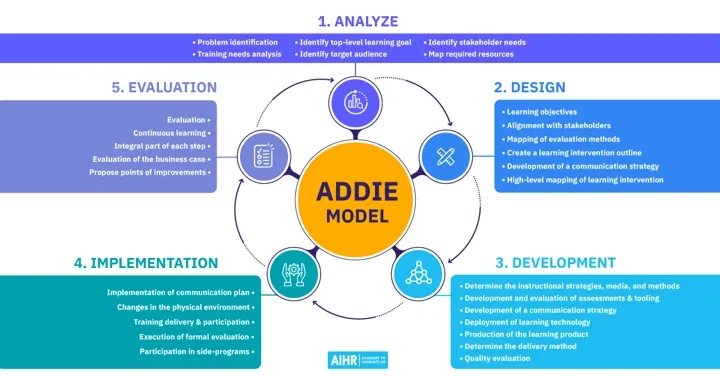
Now that we have touched base on the ADDIE model, let’s start with the first step—Analyze—and how it applied to my course.
Analyze: Research the Course Foundation with AI
Like any educational course, you start with the Analyze stage of ADDIE. This stage is where you identify the problem and the learning requirement for your course.
I first wanted to identify which pain point I am trying to solve with my "Dance Your Way Through Job Hunting: 5-Minute Mood Boost Course."
I needed help understanding the trends, patterns, and correlations within my peer universe. Additionally, I wanted to apply a few of the "5 Ws and an H" rules, which helped me structure my planning process comprehensively.
I asked myself the following:
- Who is my course for? (Identifying my audience characteristics and needs).
- What will my training be about? (Clearly define the subject and content of my course).
- When is my course going to be finished? (Establishing a detailed timeline for my course).
- Where is my course taking place? (Choose my appropriate delivery mode and location).
- Why am I building this course? (Articulate my learning objectives and goals of my course).
- How am I going to achieve this course? (Outline the methodology and resources required).
Now, let's dive into some compelling use cases, shall we?
I leveraged AI tools to deeply understand my target audience's challenges and needs by engaging with tech peer groups and social media communities.
Here are some practical use cases of how AI transformed my audience research process.
Use Case: AI-Driven Community Analysis
Objective
I wanted to identify the specific mental health challenges in job-hunting scenarios and what people do to stay happy.
My approach
In my case, I used Browse AI —a tool that automates web data extraction and monitoring—enabling me to easily collect and track information from websites without coding.
Browse AI is available both as a web app and a Chrome extension. Its flexibility spans a range of uses, including conducting market research, analyzing competitors, generating leads, tracking prices, and creating content—all for an affordable price range. I was curious to see how easy it would be to transform my online research and analysis with little programming skills.
Its user-friendly interface allows me to easily collect data without programming. I liked that you could train robots or use prebuilt ones to scrape and monitor data from various sources, including Google, Upwork, LinkedIn, and more, in only a few minutes.
You simply point and click to show it what data you want, and its clever robots will do the rest, turning messy web pages into structured spreadsheets. Think of it as having a super-fast research assistant working for you 24/7. It easily connects to Google Sheets, Zapier, Airtable, and more or downloads the data as a spreadsheet.
A similar tool is Import.io, which also offers web scraping functionalities but was ultimately not selected due to specific needs in ease of use, customization options, and the fact that you needed to book a demo to try it out.
With these considerations in mind, I turned my attention to Browse AI's templates of prebuilt robot automation.
While scrolling through, I found the Reddit pre-built bots to dig a little through Reddit comments.
The robot scraped posts from Reddit based on my desired keywords:
“Job hunting mental health.”
This way, I could easily extract data from relevant Reddit discussions, enabling me to see up-to-date posts on my topic of interest.
In addition, I used the Reddit search results bot, which allowed me to analyze Reddit comments based on my desired keywords.
With this prebuilt robot, I was able to see when the comment was posted, the upvotes of the comment, subreddit links, post titles, post link, post time, post upvotes, and post comments.
This is what it produced:
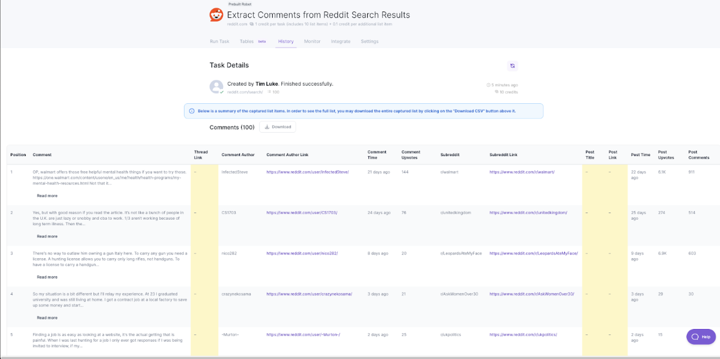
After downloading all my data, my next step was to feed it into ChatGPT to understand if mental health was taking a toll on job hunters and how they are navigating these difficulties by prioritizing their well-being.
If you’ve been able to avoid ChatGPT and haven’t heard of it yet, let me introduce you to it.
ChatGPT is an artificial intelligence chatbot crafted by OpenAI. This chatbot isn't just any AI—it's engineered to mimic human-like conversations, responding to written prompts. ChatGPT is powered by machine-learning technologies, absorbing text data to refine its responses. This means it's continually getting smarter, aiming to offer “mostly” accurate and genuinely useful answers.
ChatGPT is free for various uses, such as writing and coding, but there's also a paid subscription for ChatGPT Plus that offers benefits like guaranteed access, GPT-4, quicker responses, and internet access through plugins.
This versatility made ChatGPT an ideal tool for my next step: analyzing community data to uncover trends and commonalities, for which I had already gathered information with Browse.ai.
The best way to ask ChatGPT is by using prompts.
The prompt for my first step was:
"Please identify any patterns or trends in these community threads that summarize the main problems of job hunting?"
Here is what it summarized:
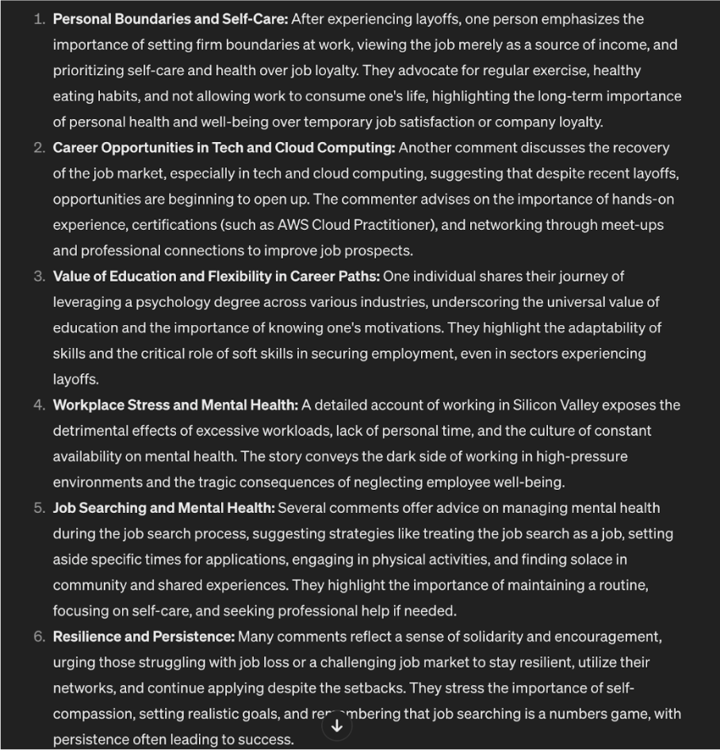
After I had gathered the trends, I wanted to see how these pain points around mental health could be tied back to dance.
So, I asked ChatGPT the following prompt:
“Please see if any of these points above could be improved with dance breaks.”
Luckily, ChatGPT came to the same conclusion as me: that dance helps job seekers stay mentally healthy.
See the proof in the screenshot below:
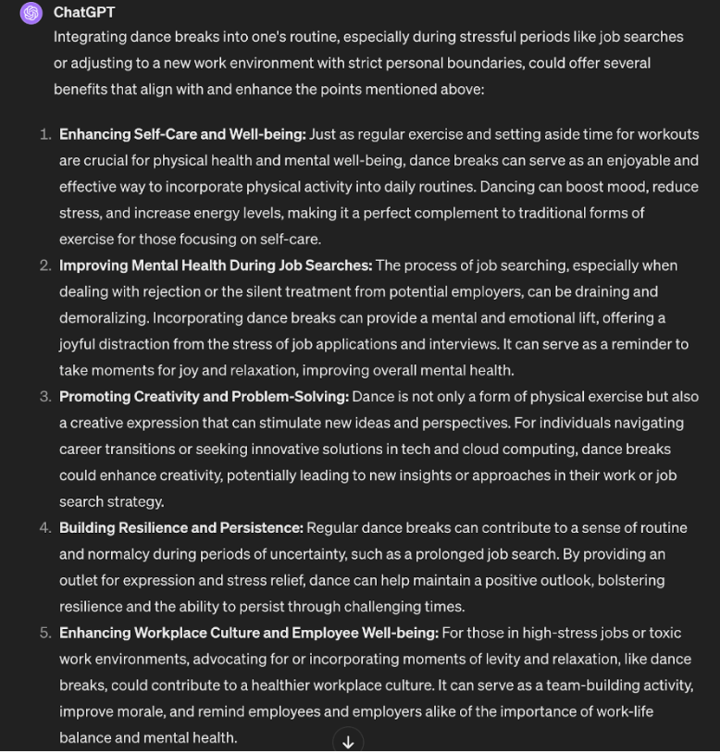
Conclusion
The time it would have taken me to go through Reddit threads and summarize the comments to see the pain points of job hunters would have roughly taken me 1 hour and 40 minutes for 100 comments if I spent an average of 1 minute per comment. With Browse.ai and ChatGPT, it only took me 20 minutes! This estimate, of course, depends on the comments' length, the complexity of the topic, and how detailed I go through the threads.
Let’s sum up the pros and cons of Browse.ai.
Pros:
- Real-time extraction
- Less time spent on research
- Scheduled data extraction
- Automated web data extraction
- Build your own bots
Cons:
- Misinformation or summary of data
- Can’t extract comments from all websites, such as LinkedIn
- Costs
- Dependency on data quality
- Limitations handling complex data
💡Tip: Start small by using built-in templates provided by Browse.ai and gradually tackle more complex projects as you gain familiarity, as big web scraping or monitoring projects can use up your credits or robots fast, possibly forcing you to pay more for extra credits or a higher plan.
How AI-driven Community Analysis Can Benefit You as a SaaS Customer Educator
As a Customer Educator, you want to educate and help your customers understand your product. Beyond that, you need to ensure that you support your customers throughout their journey, meaning you need to engage, inform, and support them throughout it.
Working with your Community, CS, or Marketing team will help you identify how your customers like to engage and what kinds of dialogues and conversations they are having about your product and training materials.
Understanding Customer Sentiments and Challenges
The use case of AI-driven community analysis, specifically focusing on identifying knowledge gaps, sentiments, trends, and challenges your customers face around your product and in their jobs, is invaluable. Understanding what they’re looking for in terms of job knowledge can help you become a more effective educator. As they improve in their roles, they'll better understand your product and how to use it.
Monitoring discussions related to your product or industry on platforms like Reddit, social media platforms, or your community platform can help you gain insights into user frustrations, usage barriers, and desired features.
This insight allows you to tailor your educational content, such as creating video tutorials or webinars focused on educating them and enhancing their user competence and confidence.
From Community Insights to Content Development, the wealth of data gathered from community analysis can inform the creation of content that directly addresses user needs and interests. The real-life challenges and solutions identified through your analysis can be woven into your educational materials, making them more relatable and impactful.
Vice versa, you can help the community team increase engagement by providing engagement strategies and content that resonates with the community.
Another way to engage with your community is to use tools like SproutSocial, Hootsuite Insights, or Brand24 to understand user sentiment. These platforms are excellent for tracking brand mentions, analyzing sentiment, and identifying trends within your community.
All in all, the application of AI-driven community analysis extends far beyond basic data collection—it's about harnessing insights to create a more engaging, supportive, and personalized educational journey for your customers.
Once you understand the specific needs and challenges of your customer community, you can level up the overall customer experience, encourage product adoption, and foster a loyal user community.
Use Case: AI-Enhanced Interview Analysis
Objective
Collect detailed feedback and experiences from job seekers while recognizing patterns.
My Approach
My first step was figuring out some good questions to ask my job seeker of choice. What better way than to use our old AI friend, ChatGPT, for that?
As I had been using the paid version of ChatGPT for my interview prep by asking ChatGPT to help me answer interview questions and generate common interview questions for my job hunt, I thought it was perfect to use for my interview questions for my job seeker. As mentioned in the use-case before, you want to make sure your prompt is a balance of specificity, natural language, and context.
I used the prompt:
“Please generate 5 questions that capture the need for a job seeker to take the course “Dance Your Way Through Job Hunting; 5-Minute Mood Boost Course.”
Here are some of the questions it generated for me:
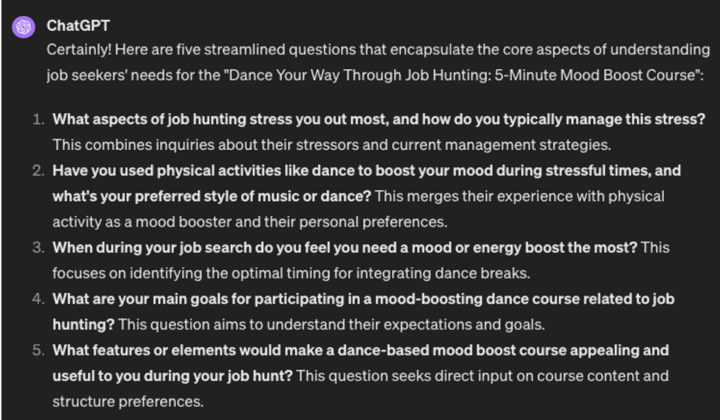
Once I had checked through the interview questions, I was ready to meet my jobhunter. I wanted to fully focus on the conversation and capture the full context of the interview to help gather insights later on.
Fathom is an AI notetaker that lets you transcribe and summarize meetings, allowing you to focus on the conversation. It works seamlessly with Zoom, Microsoft Teams, and Google Meet, and integrates with other popular business tools such as HubSpot, Salesforce, and Slack, enabling effortless sharing and collaboration across teams. All you need to do is download the tool, and it will start recording on Google Meet, Microsoft Teams, or Zoom. After the call, you will jump to the Fathom dashboard, which will look something like this below:
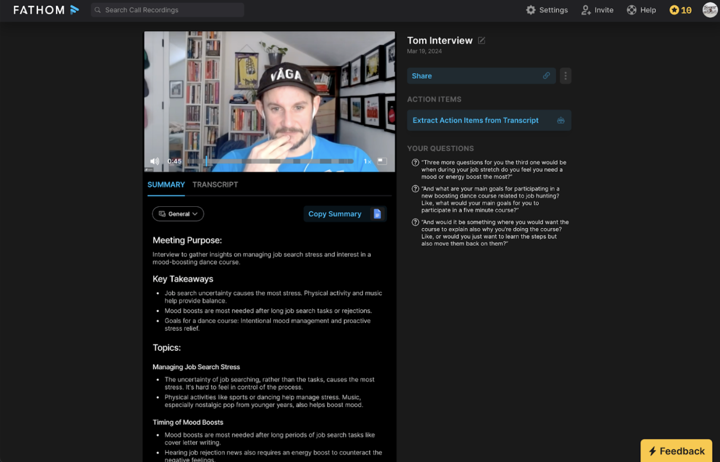
You can either have the full video transcript or make a copy of it. It also gives you many options to summarize your call, depending on your role. Besides that, it lets you easily mark important parts of a video in different colors with just one click and quickly note down actions from meetings, which are turned into a checklist by Fathom AI, ensuring you don't miss anything. Plus, you can save these notes and highlights from different meetings for later review. It also offers the ability to mark up meeting transcripts and provides templates for meeting summaries.
The feature that I found most helpful for my specific use case was the chronological summary of the meeting by chapter, the general capturing of my call's insights and the key takeaways, along with the recap of questions and answers.
I particularly appreciated the General option as it provided great insight into the responses and also suggested actions to take.
Please see the full summary here:
Meeting Purpose:
Interview to gather insights on managing job search stress and interest in a mood-boosting dance course.
Key Takeaways
- Job search uncertainty causes the most stress. Physical activity and music help provide balance.
- Mood boosts are most needed after long job search tasks or rejections.
- Goals for a dance course: Intentional mood management and proactive stress relief.
Topics:
Managing Job Search Stress
- The uncertainty of job searching, rather than the tasks, causes the most stress. It's hard to feel in control of the process.
- Physical activities like sports or dancing help manage stress. Music, especially nostalgic pop from younger years, also helps boost mood.
Timing of Mood Boosts
- Mood boosts are most needed after long periods of job search tasks like cover letter writing.
- Hearing job rejection news also requires an energy boost to counteract the negative feelings.
Goals for a Dance Course
- Make mood boosting more intentional and proactive, rather than just reactive.
- Learn some science behind the mental health benefits of dance.
- Include some history and context about the dance styles.
Desired Course Features
- Fun, accessible, educational
Next Steps:
- Design mood-boosting dance course curriculum based on insights.
- Follow up with Tom on course progress.
Conclusion
I am a huge fan of transcription tools like Fathom, as they significantly simplify life. Typically, you could spend around 3.5 to 5.5 hours in total on an interview. This includes devising the interview questions, conducting the interview, transcribing it, taking detailed notes, and creating a summary of the findings.
Of course, the time required will vary based on the interview's complexity, the transcription method used, and the level of detail you aim for in your notes and summary. This approach is particularly beneficial when meeting with your SME (Subject Matter Expert) to ensure you don’t miss any valuable information. Using ChatGPT and Fathom, this all took me less than 30 minutes!
Pros:
- Real-time audio and text transcription.
- Less time is spent on note-taking, allowing more time to engage with the subject matter expert.
- Efficient summarization of discussions.
- Integration with platforms like Zoom, HubSpot, Asana, Close CRM, Salesforce, and Slack.
Cons:
- Privacy concerns.
- Dependence on the quality of audio.
- Potential for inaccurate summaries and contextual errors.
- The cost associated with using advanced features.
- Possible bias towards certain accents, dialects, or languages, which could lead to transcription errors.
💡Tip: Big Brother is watching you! Don’t forget to turn off Fathom AI; sometimes, teams or customers might be put off by being recorded or confused if Fathom shows up before the person they are meeting. Also, I had trouble uninstalling it from my Mac when I was trying to join a Zoom call. What I did, in the end, was to uninstall both Fathom and Zoom and then reinstall Zoom
Other tools you could look into that are similar to Fathom AI are Otter.ai, tl;dv, and Firelies.ai.
Otter.ai is great for professionals who need accurate and efficient transcriptions, as it has AI-powered features like speaker identification and keyword search. Additionally, there is a feature called Otter Chat, which simplifies answering questions about meeting content, requesting further information about speakers, or generating summaries suitable for future emails or social media updates. Otter could be your preferred choice if you require only English language support and prioritize real-time transcription and flexibility.
If you need more languages and like the sound of unlimited recordings, tl;dv might be a good option. You can record countless meetings without concerns over caps or extra charges. Furthermore, its compatibility with Google Meet and Zoom ensures effortless recording of your virtual meetings. Plus, with transcription support for more than 20 languages, tl;dv emerges as a flexible and universally accessible tool.
Last but not least is Fireflies.ai, a Reddit thread favorite. Fireflies integrates with apps like ClickUp, Notion, Slack, and Salesforce. It excels in transcription, summaries, and search functionalities. Its collaboration with OpenAI enhances its offering with innovative AI-driven features such as soundbite generation and sentiment analysis. Unlike Fathom and Otter, Fireflies' open API allows customized AI enhancements, enabling a more tailored user experience.
Ultimately, there are a lot of AI notetaker tools out there, and it will come down to the pain points you are trying to solve and if other teams already have tools they use for notetaking that you might be able to use. Now, let's dive into the exciting ways you can leverage these AI-powered notetakers to transform your day as a Customer Education professional.
How AI-Enhanced Interview Analysis Can Benefit You as a SaaS Customer Educator
Where to start?
There are so many ways you can use this notetaker power. One scenario could be you get brought in to relaunch a whole help center or academy. A good thing to do is have interviews with your company advocates and power users to see what they need and what they use when utilizing other help centers. This way, you stay close to your customer and listen to their voice.
By understanding customer needs and challenges through interviews, you can gain direct insights into customers' specific needs, challenges, and pain points. By using the help of a notetaker, you can sum up the trends you are hearing quickly and present them in your next strategy meeting. This understanding enables the creation of educational content that is highly relevant and directly addresses the issues that customers encounter.
Too often, we see companies building out content that doesn’t match the customers' needs.
Let’s think beyond the Analyze phase and imagine you have created your first course. Feels good, right?
Now, let’s imagine a way for you to get valuable feedback to optimize your course. By understanding what motivates customers and what they find engaging, you can design learning experiences that capture users' interest and encourage active participation. This could include incorporating elements like storytelling, interactive exercises, or real-world examples that resonate with the audience. All you need to do is paint a picture using the notes and videos you have from previous interviews.
The best thing about AI notetakers is that the information is there for you to share with other teams.
Wouldn’t it be great if your insights could also be valuable for marketing and sales teams?
Understanding the customer journey and educational needs can help craft more targeted marketing messages and sales pitches that resonate with potential users. On the flip side, you can see if your CS and Sales teams are already using software with an AI notetaker built-in and search through the trends and keywords to inform your Customer Education strategy and content.
Another great thing to do when starting as a Customer Education lead is to identify any knowledge gaps in direct conversations with customers. SMEs can uncover gaps in understanding or misconceptions about the product. It can help you go through the customer journey and quickly implement knowledge where needed because now you have transcript proof that can be translated into great content pieces to help your customers and SMEs.
Having pinpointed the knowledge gaps through direct conversations, the next step is harnessing the power of AI to bring these insights to life in a compelling and easily digestible format.
Use Case: Visualizing the Gaps with AI
Objective
Create a visual representation of the job hunting levels of frustration and demotivation.
My Approach
AI-powered data analysis and visualization tools can help you understand trends, patterns, and correlations within your organization’s data. The one I chose was ChatGPT. The reason for this was the lack of data resources. I needed to get innovative, as I didn’t have my own data sets.
That said, I could still gather some data about job seekers and the benefits of dance for mental health via Google. I used ChatGPT to provide me with different types of graphics.
The first thing I wanted to visualize was the number of people who are job-seeking and how many of them are suffering mentally. I researched online and found some data on this from other studies.
I uploaded this data into ChatGPT and used the prompt:
"Please show a bar graph that visualizes the number of people who are job-seeking and how many of them are suffering mentally."
And this is what it spit out:
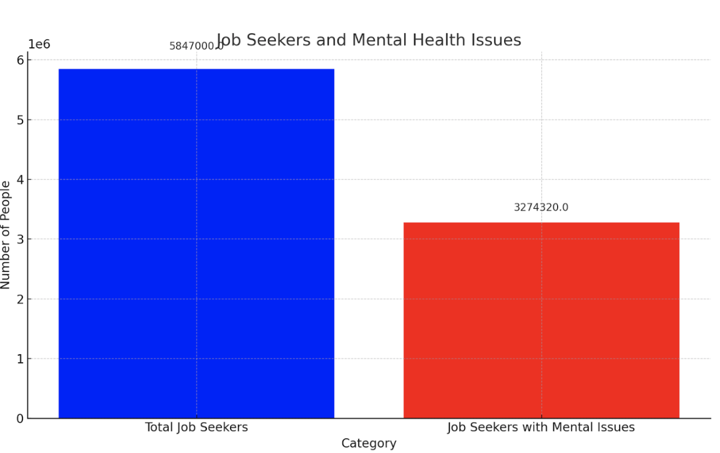
Then, I wanted to dig deeper and asked ChatGPT this:
"Please create a pie chart showing the most common problems during job searching."
This is what was created for me:
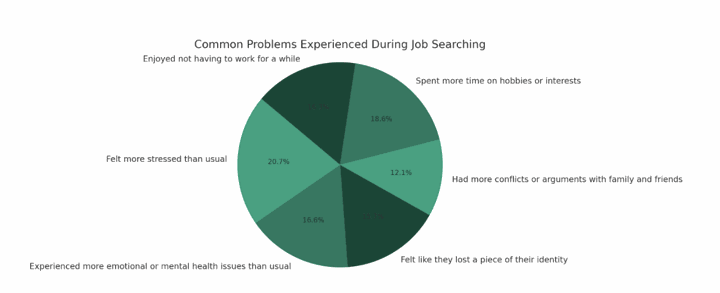
After seeing what most people are suffering from, I needed to know what people do to stay happy and then see how dance influences happiness in people. So, here we go.
I prompted ChatGPT with the following:
“Present a pie chart with the most common things people do for mental health when job searching.”
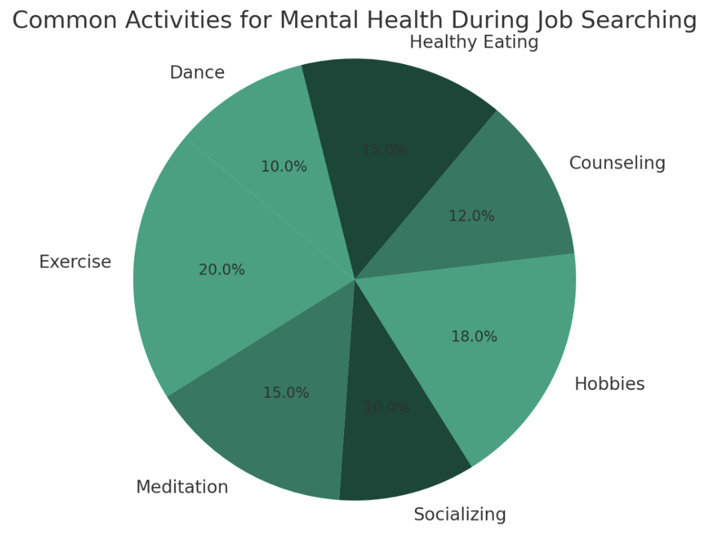
After that, I found some data about mental health to feed into ChatGPT to see how people who don’t dance compare to people who do dance mentally.
The prompt was:
"Show in a bar graph how dance has a positive effect before and after." Use this dataset for it: "Please create a bar graph that shows the 25 minutes reduced symptoms of depression by 47%, and dancing for 45 minutes reduced symptoms of anxiety by 57%."
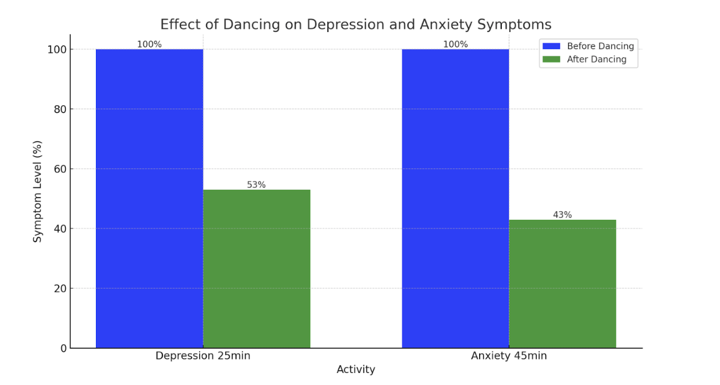
The visualizations generated by ChatGPT tell a compelling story about data, concluding that incorporating dance into one's routine could be a powerful and enjoyable strategy to alleviate symptoms of depression and anxiety significantly.
Conclusion
I liked using ChatGPT to create visuals. Did it need tweaking, and did it use data in some pie charts that I didn’t provide? Yes, but imagine how accurate it could get if you fed in your data. All, of course, with a little pinch of caution around data safety.
Did this method save me much time? Yes, it did. If I had created simple bar graphs using software like Excel or Google Sheets, this typically would have taken me anywhere from 15 minutes to an hour, depending on factors such as the size of the dataset and customization requirements.
For more complex graphs or larger datasets, the time required can range from 1 to 3 hours or even more, especially if there's a need for extensive data preparation, customization, or learning new tools.
Using ChatGPT to assist with my graph creation took me 30 minutes. So, depending on the data you are dealing with and how comfortable you are with Excel, it may or may not save you time. It will, however, probably save you from poking your busy data team for help.
Pros:
- Zero coding skills are required
- ChatGPT can provide code for generating charts and for working on code through its debugging ability.
- You don’t need to bother your data team.
- Speeds up your workflow.
- Validates themes in an easy visual.
Cons:
- ChatGPT is not flawless and may provide incorrect answers.
- Knowledge of the theoretical side of data visualization is limited.
- Inaccurate visualization needs cleaning up.
- It's essential to verify information independently rather than relying solely on ChatGPT.
- You need to feed it accurate data sets.
- It throws errors quite often.
- You can’t feed it big sets of data.
💡Tip: Want to keep your data safe and not have ChatGPT learn from you? To ensure your privacy on ChatGPT and prevent your conversations from being used for training, turn off chat history and training in Open Data Controls. Note that while OpenAI will retain your data for 30 days, you will lose access to your chat history. Additionally, consider submitting a privacy request via OpenAI's Privacy Center to opt out of training on your content. Utilizing the API instead of the chat interface further safeguards your privacy, as data submitted through the API is not used for training purposes.
Next to ChatGPT, there are many other great AI-powered visualization tools. The two I want to mention are Tableau and Polymer.
Tableau offers smart data visualization capabilities, using AI to spot patterns in your data and craft engaging visuals for clearer presentations. It also provides an AI-driven tool for data preparation, making it easier for you to tidy up, reshape, and arrange your data. The most talked-about feature is the tool's visualization options, which require no coding skills. With natural language query support, you can interact with Tableau to produce meaningful, personalized insights from your data using plain English.
Polymer is the way to go if you want to generate dashboards and provide detailed insights across teams automatically. Share links with relevant team members, embed your visualizations into your website, or add them to presentations. It lets you create professional-looking visualizations and dashboards without a steep learning curve.
Integrating Polymer into your workflow can significantly enhance your data visualization efforts as a SaaS Customer Educator. By leveraging its capabilities to generate dashboards and provide detailed insights automatically, you can effectively fill in the gaps in your data, visualize key metrics for your leadership meetings, and streamline the organization and presentation of your data.
How Visualizing the Gaps with AI Can Benefit You as a SaaS Customer Educator
As I mentioned earlier, I didn’t have all the data that you would have when working for a company, but you probably do. So, let’s explore ways you could use AI to filter out gaps, visualize your data for your next leadership meeting, and make it easier for you to tidy up, reshape, and arrange your data. Yay!
Within an organization, you could use AI-driven data analysis and predictive analytics tools for data-driven issues (like sales or digital skill gaps).
For example, AI features in HubSpot Sales Hub can significantly enhance the gap identification process by providing accurate forecasting, efficient communication summaries, detailed call analyses, automatic CRM associations, and insightful, real-time reporting.
This way you could identify any gaps and partner up with Sales and Marketing to provide top-of-funnel education or provide onboarding courses that close the knowledge gap.
One way to effectively capture the customer's voice is by leveraging AI analysis tools such as SurveyMonkey and Typeform. SurveyMonkey combines AI with machine learning to offer automated question suggestions and sentiment analysis, streamlining the survey creation and analysis process.
Meanwhile, Typeform enhances the survey experience with AI-driven language refinement, design consistency, and custom-tailored questions, making it ideal for crafting visually appealing surveys. Surveys are a great way to present to other teams that what you are working on will minimize the knowledge gap and show people results once you design your educational content.
Turning to skill and competency analysis tools equipped with AI is the way to go if you want to identify and address customer skill gaps. You can utilize a CRM with AI capabilities like ClickUp, Hubspot, or Zendesk. Zendesk allows you to analyze support tickets, customer feedback, and interaction data to identify skill gaps in your team. ClickUp can help you pinpoint gaps in the customer journey, optimize the experience, and identify areas where your competitors may outperform you. These tools will provide the data to build a case for you when starting your programs and back your business case.
Put Your AI Skills to Work
AI is a powerful way to enhance the Analysis phase and establish the foundation of the course with AI. I was able to answer who my course is for, what my training will be about, and why I am building the course—the most essential aspect of any course creation, in my opinion.
Now, I ask you, how would you answer the outstanding Ws questions, like When will my course be finished? Where is my course taking place? How will I accomplish this course?
Remember, AI is like any other tool; you will need to learn new skills and see how it can benefit your specific needs as a Customer Educator.
The technology sky is the limit!
I hope my use cases demonstrated that you can get creative with AI to make your business case for your next Customer Education program, and it can help you scale your efforts quickly and easily.
Sign up to receive notifications about the next blog in the series, which will explore the design portion of our course.
About the author
Nine Henning sprinkles creativity into marketing and enablement, transforming customer experiences into engaging journeys. Her passion for good storytelling brings any digital content and strategies for customer empowerment to life. In her free time, she immerses herself in the street dance community and dances the day away. Connect and learn more here.
